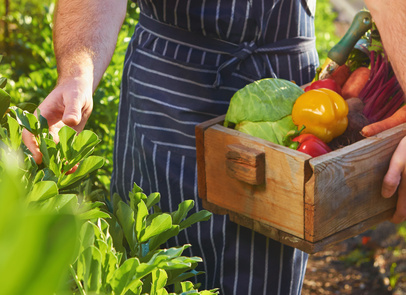 If you’ve worked in school food service for any length of time you’ve probably been approached about incorporating locally grown foods into your menus. This movement, which continues to gain momentum, is commonly referred to as farm to school. Farm to school initiatives can take on many forms but most aim to help students understand where their food comes from through education and procurement of locally grown foods. They may also include school gardens. When considering that “the average fruit and vegetable travels 2,500-4,000 miles before we consume these perishables…The impact of transporting food at such large distances is significant, effecting quality and price as well as the environment” (Vermont Farm to School: A Guide to Using Local Foods in Schools, 2007). Purchasing locally grown foods helps increase students access to and knowledge of fresh fruits and vegetables, can increase student participation in school meal programs, and boost the local economy. It’s easy to see why 44% of US schools are participating in this movement, spending nearly $400 million on local foods (http://www.farmtoschool.org/about/what-is-farm-to-school). What may be more difficult to understand is exactly how to get started. There are many factors to consider when attempting to modify food purchasing practices, but with careful planning and open communication with all stakeholders, farm to school is attainable at every school.
If you’ve worked in school food service for any length of time you’ve probably been approached about incorporating locally grown foods into your menus. This movement, which continues to gain momentum, is commonly referred to as farm to school. Farm to school initiatives can take on many forms but most aim to help students understand where their food comes from through education and procurement of locally grown foods. They may also include school gardens. When considering that “the average fruit and vegetable travels 2,500-4,000 miles before we consume these perishables…The impact of transporting food at such large distances is significant, effecting quality and price as well as the environment” (Vermont Farm to School: A Guide to Using Local Foods in Schools, 2007). Purchasing locally grown foods helps increase students access to and knowledge of fresh fruits and vegetables, can increase student participation in school meal programs, and boost the local economy. It’s easy to see why 44% of US schools are participating in this movement, spending nearly $400 million on local foods (http://www.farmtoschool.org/about/what-is-farm-to-school). What may be more difficult to understand is exactly how to get started. There are many factors to consider when attempting to modify food purchasing practices, but with careful planning and open communication with all stakeholders, farm to school is attainable at every school.
- Choose one food: Start small, identify at least one food product that you use throughout the year that can be sourced locally. Choose something that is inexpensive and versatile. If this item is only available seasonally, think about how it might be frozen and used throughout the rest of the school year.
- Build relationships: Find local farmers who can supply this food product. If you are unsure where to look, contact your local Cooperative Extension office. They may be able to help connect you with local farmers who are USDA inspected and GAP (Good Agricultural Practices) certified.
- Give a tour, take a tour: Invite farmers to tour your facilities and eat a meal. Then ask to visit the farm and sample their product. This relationship-building goes a long way toward understanding the challenges of both the grower and the food service staff. For example, farmers will need to understand your particular processing and storage needs based on the limitations of your facilities and labor. Likewise, you will need to understand the seasonal availability of each crop and labor-intensity of harvesting. Be sure to discuss any other needs such as: price point, invoicing, delivery schedule, etc.
- Work with distributors: If you are used to dealing with a wholesale distributor, find out if they are currently delivering any local produce. Educate them about your farm to school initiative and request local foods whenever possible.
- Collaborate with colleagues: Convene other area food service directors to share ideas, menu plans, and ways to share costs such as shared freezer space or centralized delivery points.
- Highlight your efforts: Plan tastings and other marketing strategies to highlight local foods. Encourage classroom collaboration through nutrition lessons, recipe contests, and other academic ties. Invite administrators, parents, elected officials, and other community partners to dine in your cafeteria. Encourage the local media to share your initiative with the community.
To learn more:
Contributor,
April Neujean, Cornell Cooperative Extension of Jefferson County
